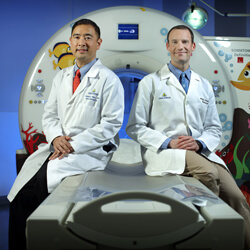

A worry, especially for young growing bodies, is that the necessary and frequent CT scans needed to monitor the shunts carry a risk for cell damage and cancer.
A Johns Hopkins team led by neurosurgeons Edward Ahn and Jonathan Pindrik, in collaboration with Thierry Huisman and Aylin Tekes from pediatric neuroradiology and Mahadevappa Makesh from imaging physics, recently developed a technique that reduces radiation exposure without compromising diagnosis and patient care. Instead of taking the usual 32 to 40 CT “slices,” the method requires just seven slices, thus reducing X-ray exposure by more than 90 percent.
“We have been searching for ways to minimize radiation exposure in kids without sacrificing the diagnostic accuracy of the images, which is no easy feat,” says Ahn. “We believe that our limited-slice CT scans achieve that balance.”

